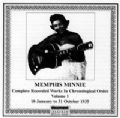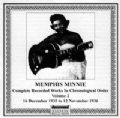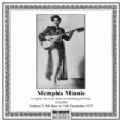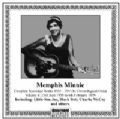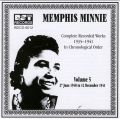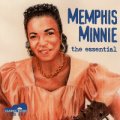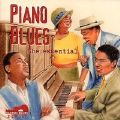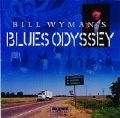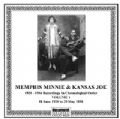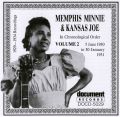"Search Document Records - Memphis Minnie Results "
Viewing 1 to 10 of 15
Memphis Minnie Vol 1 1935 Memphis Minnie; vocal, guitar. With contributions by; Black Bob, piano; Casey Bill Weldon, slide steel guitar, and others... Genres: Country blues / early Chicago blues. With her musical and personal relationship with Kansas Joe McCoy ended, new directions inevitably had to be sought for Memphis Minnie’s recording career. An air of experimentation can be detected in her first visits to the recording studio in 1935. The January 10th session is distinguished by a fine pianist whom she addresses as “Jimmie”, which is generally taken to indicate Jimmie Gordon. Two of the numbers recorded are stomping bawdy songs, Sylvester And His Mule is textually more interesting. Telling of a cotton-pickers’ (successful) appeal to President Roosevelt, it reflects optimism in the black community about the New Deal. Continued... More Info on our New Store >> |
||
Memphis Minnie Vol 2 1935 - 1936 Memphis Minnie; vocal, guitar. December 1935 found Memphis Minnie back in the Chicago studios of what was then the American Recording Company and she would record for no one else for fourteen years. After the experimentation of 1935, the emphasis in her recording career now shifted decisively to the band sound characteristic of Chicago in the later thirties. The changes reflect a demand for overtly danceable rhythms and can be seen as an early portent of the process by which blues merged with small-band swing to become rhythm and blues. Continued... More Info on our New Store >> |
||
Memphis Minnie Vol 3 1937 Memphis Minnie; vocal, guitar. Genres: Chicago Blues Informative booklet notes by Howard Rye. Memphis Minnie’s ‘band period’, discussed in the notes to BDCD-6009, continued through 1937 though with some changes in emphasis. Seven months elapsed after the session of November 1936 before she returned to the Vocalion studios. A trumpeter was again on hand playing in a fiery style. Certainly, some listeners will feel that this rough, blues style is appropriate to the task of accompanying Memphis Minnie. The pianist on the June 1937 sessions plays a much less prominent role than Black Bob had played during 1936. Whoever was involved, the result is that Minnie herself dominates these sessions, aggressive both instrumentally and vocally. “You can’t take my money, man, and rule me too!”, she cries, “I done got tired of your 3-6-9” an allusion to the number combination for excrement (i.e. shit) in the lore of the policy game. Continued... More Info on our New Store >> |
||
Memphis Minnie Vol 4 1938 - 1939 Memphis Minnie; vocal, guitar. With contributions by;Little Son Joe, vocal guitar.Charlie McCoy, mandolin. Black Bob, piano and others... Informative booklet notes by Howard Rye. Memphis Minnie had only one recording date in 1938. Its unusual atmosphere is attributable in main to Charlie McCoy’s mandolin, which introduces a whiff of string bands and minstrelsy, especially noticeable on Long As I Can See You Smile. Genuine double meanings are rare, but the advice in Good Biscuits, “Don’t let no outside woman bake no biscuits for you man,” is equally valid whether taken literally of metaphorically, not that I imagine that the literal meaning was uppermost in the minds of either performers or listeners. The theme is continued in Keep On Eating. Minnie obviously belied in the old saying that the way to a man’s heart is through his stomach. Continued... More Info on our New Store >> |
||
Memphis Minnie Vol 5 1940 - 1941 Memphis Minnie; vocal, guitar. Includes; Little Son Joe, vocal, guitar and others... Genres: Memphis / Chicago Blues Informative booklet notes by Howard Rye. After the long interval since their previous session Minnie and Joe’s June 1940 session is marked by a sense of commanding confidence, and notably inspired instrumental choruses. “You may go to Hollywood and try to get on screen, The reminiscent mood extends to the remarkable Ma Rainey, a tribute to an acknowledged influence who had died in December 1939. It is replete with the paradox of wondering in the first verse, “where could Ma Rainey be”, and making clear in the last that she is known to be dead: “People, it sure look lonesome, since Ma Rainey been gone, Continued... More Info on our New Store >> |
||
Memphis Minnie, the essential DOUBLE CD More Info on our New Store >> |
||
Piano Blues, the essential DOUBLE CD More Info on our New Store >> |
||
Bill Wyman's Blues Odyssey DOUBLE CD Double CD
Various Artiists
Compiled by Bill Wyman
Informative 24 page full colour booklet by Bill Wyman & Richard Havers
Detailed discography
Rolling Stones bassist Bill Wyman asked Document Records to produce a CD which would be part of a life long ambition; to pay tribute to and share with others the music that he has loved and been influenced by, The Blues. This double CD, accompanied by a twenty-four page colour booklet, compliments the book, television documentary and DVD of the same name. It features some of the very best blues to have been recorded from the early “Classic” female blues and “Country Blues” of the nineteen-twenties through to the electric “Down Home” blues of Chicago.
Whether you are a collector or just inquisitive about what the blues are and the history the music, this CD is one of the finest collections of vintage blues recordings available. Continued... More Info on our New Store >> |
||
Memphis Minnie & Kansas Joe Vol 1 1929 - 1930 Kansas Joe (Joe McCoy), vocal, guitar.
Memphis Minnie, vocal guitar.
With contributions by: Memphis Jug Band: Will Shade, harmonica; Charlie Burse, guitar; Hambone Lewis, jug.
Genres: Country Blues, Memphis Blues, Country Blues Guitar.
Informative booklet notes by Alan Balfour.
Detailed discography.
From this albums booklet notes:
Recording as "Kansas Joe" and "Memphis Minnie" at their 1929 debut recording session the couple cut six numbers, three featuring Kansas Joe as a vocalist, two with Minnie taking the vocals and the third found them duetting. These recordings weren't afforded immediate issue but were released over a period of time. For example, the coupling Bumble Bee / I Want That was not on sale until some fifteen months later. It was to be the suggestive "Bumble Bee" ("Got the best stinger I've ever seen") that was to make Memphis Minnie. So successful was the song that Victor "borrowed" Minnie to record a version fronting a caucus of the Memphis Jug Band. Vocalion then responded with Bumble Bee No. 2 and New Bumble Bee. The song was such hot property on the race market that in the last six months of 1930, unreleased recordings apart, there were no fewer than five versions, on three different labels, of "Bumble Bee" — three of which are present on this compilation. Continued...
More Info on our New Store >> |
||
Memphis Minnie & Kansas Joe Vol 2 1930 - 1931 Memphis Minnie, vocal, guitar; Kansas Joe McCoy, vocal, guitar.
Genres: Memphis Country Blues, Country Blues Guitar.
Informative booklet notes by Alan Balfour.
Detailed discography.
From this album's booklet notes:
This compilation represents Memphis Minnie and Kansas Joe’s first encounter with the Chicago. Between June 1930 and January l931 the pair recorded on several occasions and cut several dozen titles. However, as a result of America's slide into depression, most songs took many months to release and with the exception of the coupling, "I Don't Want No Woman I Have To Give My Money To" / Cherry Ball Blues, nearly all songs recorded during June were left on the shelf. Subsequently they were issued with items from later sessions. Vocalion's follow-up release, What's The Matter With The Mill / North Memphis Blues, didn't appear until November featuring titles recorded in October, the former ostensibly about a broken down corn mill but in reality sexual innuendo and the latter, apparently in praise of the culinary delights to be found at a Memphis cafe, is thought by some commentators to concern a house of ill repute! Continued... More Info on our New Store >> |
||

